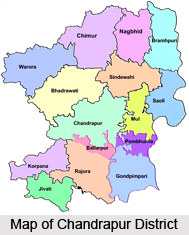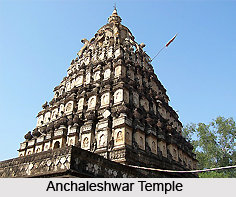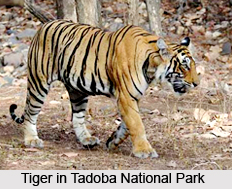 Chandrapur district was the largest district in all of India before it was split into the two separate districts of Gadchiroli and Chandrapur. It is currently a part of the Napur division of the state of Maharashtra. The district is famous for its super thermal power plant which is one of the biggest in Asia and it has vast coal reserves. It is one of the largest reservoirs of limestone and therefore there are a lot of cement factories like Larsen and Tubro (now Ultratech) Gujarat Ambuja (Maratha Cement Works), Manikgard and ACC. The district covers a total area of 11,443 Sq. Kms which constitutes 3.72 percent of the total area of the state. Among the major languages spoken in the district are the Marathi language, Gondi language, Kolam and Hindi language. Further details about the district are furnished below.
Chandrapur district was the largest district in all of India before it was split into the two separate districts of Gadchiroli and Chandrapur. It is currently a part of the Napur division of the state of Maharashtra. The district is famous for its super thermal power plant which is one of the biggest in Asia and it has vast coal reserves. It is one of the largest reservoirs of limestone and therefore there are a lot of cement factories like Larsen and Tubro (now Ultratech) Gujarat Ambuja (Maratha Cement Works), Manikgard and ACC. The district covers a total area of 11,443 Sq. Kms which constitutes 3.72 percent of the total area of the state. Among the major languages spoken in the district are the Marathi language, Gondi language, Kolam and Hindi language. Further details about the district are furnished below.
Location of Chandrapur District
Chandrapur district is located in the eastern edge of Maharashtra in Nagpur division and forms the eastern part of `Vidharbha` region. It is located between the latitudes of 19.30 degrees north and 20.45 degrees north, and 78.46 degrees east longitude. It is the easternmost district of the state of Maharashtra. The district is bounded by Nagpur, Bhandara and Wardha on the northern side, Yavatmal district on the western side, Gadchiroli on the eastern side and Adilibad district of Andhra Pradesh on the southern side. Physiographically, the district is situated in the Wainganga and Wardha river basin. The eastern and western boundaries of the district are well defined by the river Waingabga river and the Wardha, the tributaries of Godavari river. Chandrapur district occupies an area of 11,443 sq. Km. which constitutes 3.72 percent of the total area of the state.
 History of Chandrapur District
History of Chandrapur District
In the past Hindu and Buddhist kings ruled the area for a long time. In 1854, Chandrapur formed an independent district and in 1874 it comprised the three tehsils Mul, Warora and Bramhpuri. A new tehsil with headquarter at Gadchiroli was created in 1905 by the transfer of zamindari estates from Bramhpuri and Chandrapur tehsil. In 1907 a small zamindari tract from Chandrapur district was transferred to the newly formed districts. After India`s independence in 1947, the former Central Provinces became the new Indian state of Madhya Pradesh. No major changes occurred in the boundaries of the district or its tehsils between 1911-1955. In 1956, during the linguistic re-organisation of states, the Marathi-speaking district of Chandrapur was transferred from Madhya Pradesh to become part of Bombay State. Rajura tehsil, a part of Adilabad district of Hyderabad state, was transferred to Nanded district subsequently it was transferred to Chandrapur district in 1959. The district became part of Maharashtra since its creation in May 1960. In order to lessen the administrative burden in 1981 this district was again divided into Chandrapur and Gadchiroli. Chandrapur district now comprises the tehsil of Chandrapur, Bhadravati, Warora, Chimur, Nagbhir, Bramhpuri, Sindhewahi, Mul, Gondpipri, Pomburna, Saoli, Rajura, Korpana, Jivati and Balharshah.
Geography of Chandrapur District
The climate of the district can be classified as tropical hot climate with high temperatures throughout the year. The two prominent seasons of the district are the very hot summer and moderate winter. Winter season is short and mild while the summers are hot and prolonged. After the summer, comes the monsoon, which lasts till late September. There is no drought prone area in the district as the southwest monsoon brings a lot of rainfall. The average annual rainfall is about 1420 mm. The eastern part receives more rainfall than the west. Average no of rainy days is 60 to 65 through out the district. The humidity level in the district is very high during the monsoons, which fall down during the summer season. The temperature starts decreasing from the month of October. December is the coldest month. During the summer season the temperature rises as high as 46 degree Celsius, and the district is amongst the highest temperature in the South Asian region. Usually the wind blows from south to north. In summer the wind blows from east to and south and during the monsoon from south to east. During winter, the wind direction changes from north to east. The region is a part of the Godavari basin. The three tributaries of the Godavari flow in this region. They are the Wardha, the Wainganga and the Penganga rivers. The main river of the district is the Wainganga River, which flows along the border of Chandrapur and Gadchiroli district. The Wardha is the only perennial river in the district. The Penganga River that flows along the western border takes east west course and then joins the Wardha River at Wadha near Ghugus.
 Education in Chandrapur District
Education in Chandrapur District
In Chandrapur district, a large variety of educational facilities exists to cater to the needs of a population of 17.71 lakh (as per the Census of 2001). In 2001, there were 2246 primary schools, 422 middle schools, 212 secondary schools, 37 higher secondary/PUC/intermediate schools, 29 colleges, 77 adult literacy centres and 49 vocational training institutions. They are distributed all over the district while higher order facilities like colleges, vocational training institutions etc, are mostly found in towns, the primary schools, middle schools, adult literacy centres etc predominate in the villages.
Tourism in Chandrapur District
There are a number of ancient temples located in Chandrapur, such as the temples of Ankleshwar (Lord Shiva) and Mahakali (Goddess Mahakali). Tadoba National Park near Chandrapur is one of India`s 28 Project tiger reserves and one of the famous tourist spots in all of Maharashtra. Other tourist places are Ramala Tank, Junona Tank at Chandrapur, Ghodazari Project, Satbahini Tapovan at Naghbir, Adyal Tekari at Bramhpuri, Ramdegi at Chimur.






